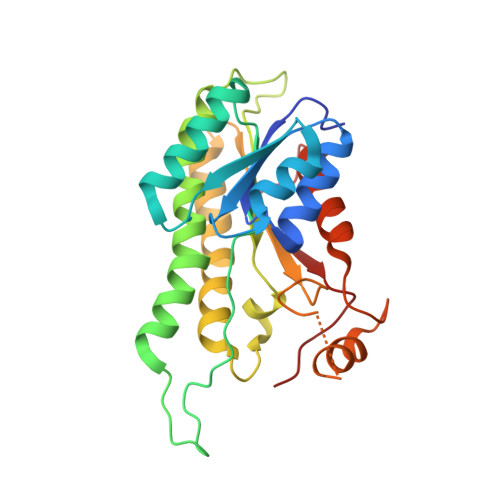Recognition of Structurally Diverse Substrates by Type II 3-Hydroxyacyl-Coa Dehydrogenase (Hadh II) Amyloid-Beta Binding Alcohol Dehydrogenase (Abad)
Powell, A.J., Read, J.A., Banfield, M.J., Gunn-Moore, F., Yan, S.D., Lustbader, J., Stern, A.R., Stern, D.M., Brady, R.L.(2000) J Mol Biology 303: 311
- PubMed: 11023795
- DOI: https://doi.org/10.1006/jmbi.2000.4139
- Primary Citation of Related Structures:
1E3S, 1E3W, 1E6W - PubMed Abstract:
Human type II hydroxyacyl-CoA dehydrogenase/amyloid-beta binding alcohol dehydrogenase (HADH II/ABAD) is an oxidoreductase whose salient features include broad substrate specificity, encompassing 3-hydroxyacyl-CoA derivatives, hydroxysteroids, alcohols and beta-hydroxybutyrate, and the capacity to bind amyloid-beta peptide, leading to propagation of amyloid-induced cell stress. In this study, we examine the structure and enzymatic activity of the homologous rat HADH II/ABAD enzyme. We report the crystal structure of rat HADH II/ABAD as a binary complex with its NADH cofactor to 2.0 A resolution, as a ternary complex with NAD(+) and 3-ketobutyrate (acetoacetate) to 1.4 A resolution, and as a ternary complex with NADH and 17 beta-estradiol to 1.7 A resolution. This first crystal structure of an HADH II confirms these enzymes are closely related to the short-chain hydroxysteroid dehydrogenases and differ substantially from the classic, type I 3-hydroxyacyl-CoA dehydrogenases. Binding of the ketobutyrate substrate is accompanied by closure of the active site specificity loop, whereas the steroid substrate does not appear to require closure for binding. Despite the different chemical nature of the two bound substrates, the presentation of chemical groups within the active site of each complex is remarkably similar, allowing a general mechanism for catalytic activity to be proposed. There is a characteristic extension to the active site that is likely to accommodate the CoA moiety of 3-hydroxyacyl-CoA substrates. Rat HADH II/ABAD also binds amyloid-beta (1-40) peptide with a K(D) of 21 nM, which is similar to the interaction exhibited between this peptide and human HADH II/ABAD. These studies provide the first structural insights into HADH II/ABAD interaction with its substrates, and indicate the relevance of the rodent enzyme and associated rodent models for analysis of HADH II/ABAD's physiologic and pathophysiologic properties.
- Department of Biochemistry, University of Bristol, Bristol, UK.
Organizational Affiliation:


















